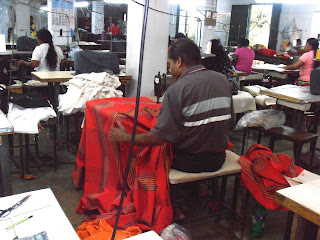We had a pleasant lunch at the Paradise Road outlet in Colombo and explored their enormous range of custom designed and locally made home ware housed in an old colonial residence that has been converted to its purpose. There are two stories of rooms, small and large, stacked with china, metalware, wooden items and, of course, textiles.
The bus then took us to the Kandygs textile factory a little out of Colombo at Maharagama. The city seems to be more and more choked with traffic, and progress was frustratingly slow at times. Our destination proved to be quite a surprise in its location - instead of the industrial area that I expected to see we turned into a small suburban street with pretty houses and lush gardens. The high gates opened to a treed compound with low buildings set on three sides.
Factory building
We were introduced to a gracious older woman who is the owner of the family run business that comprises four retail outlets and a large factory of two hundred hand looms and thirty power looms. They also have a hundred weavers working in a home situation, mostly in the town of Gampaha. The business manager, a bright young man named Chathuranga Wickramarathne was assigned to show us around the complex. He apologised that the workers were on a tea break, and soon a bell sounded and they cheerfully trooped back to their work. Drinking tea at particular times is sacred to the culture of Sri Lanka and mandatory in the working day.
We started in the finishing area, where the bright bolts of cloth fresh from the weavers are checked meticulously for variations of colour or snags in the weaving. It is then distributed to the makers and the room hummed with the sound of sewing machines as men and women deftly shaped the fabric into various items of clothing. Chathuranga explained that nothing is wasted, the offcuts are turned into patchwork toys and yoga mats. Much of the work is commissioned as Kandygs exports to Japan, Germany, Greece, the UK, Netherlands, Norway, Sweden, Mexico and the Maldives. An employee of thirty years who is not very well sits quietly making cushion covers in the ornate "cathedral window" design, her task slowed to accommodate her state of health.
The finishing room
Chathuranga speaks to the group
"Cathedral window" patchwork
The cotton used is imported from India, a fin"e strand of 2/20 that is dyed on the premises with "safe" chemical dyes. The large weaving room is set up with a hundred wooden two shaft looms that are thirty or forty years old, although only about fifty are in use. On one side there is a winding area where bicycle wheels have been imaginatively co opted into the process. The whole rooms resounds to the vigorous throwing of the shuttle as the women weavers work fast to produce fabrics of varying types. Some are fine enough to drape as saris, some almost transparent and others bulky and double sided for table mats and runners. In some designs, small, separate strands of plied cotton are inserted by hand into the body of the the weave to form distinctive patterns.
Factory floor
Winding area
Weaving table runners.
Walking around you are struck by the intense heat and the low light. Neon tubes are suspended above each loom. The workers appear cheerful and industrious, unfazed by conditions under which we would be hard pressed to produce anything. Chatharunga says that the women have flexible working hours and are fed and accommodated by the factory. They also provide insurance and attend to their medical needs. Some workers will work week on and week off to return to their villages to spend time with their families. Others will start early in the morning and take a couple of hours off in the middle of the day when the heat is intense, then return to their looms until later in the evening.
As we sat perspiring on a low concrete wall admiring the garden, the head of the weaving area appeared with tall glasses of pineapple juice, a hospitable gesture that is intrinsic to every visit made in this country.
Our day ended with a wild tuk tuk ride through the night to the Colombo Rowing Club as guests of Andrea's husband Rudi. Set on the shores of the Beira Lake it is a monument to the civilisation of times past, with wood panelling and honour boards decorating the walls. We sat on an elevated open deck facing the calm waters of the lake, coloured lights penetrating its surface in shimmering rainbows. A lovely end to a busy day.







Very interesting Cress. Love the blog. Have a great time. Joh
ReplyDelete